
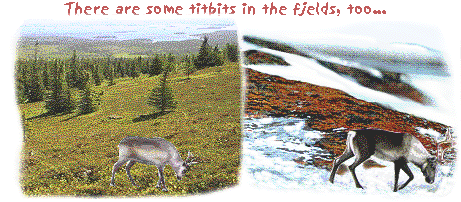
Fjelds (the first section)
There prominate on the fjelds the same types of vegetation as on the forest zone: rock-, mire- and watervegetation, as well forests on lower slopes.
Vegetation on the fjelds ° The top of a fjeld rises above the forest line, and those areas are classified as oroarctic zone (alpine belts in the picture, above). See forest lines in Lapland! ° The oroarctic/alpine vegetation is often spot-like (because the topographic/climatic variations) and the lowness of plant species. There are e.g. dry reindeer lichen areas (the proportion of reindeer lichen (Cladonia alpestris) has decreased due to reindeer grazing), but also vast dwarf birch (Betula nana) and dwarf shrub heathlands (even fjeld mires). ° Also there exist some arctic-alpine species on the oroarctic areas. ° There are a lot of snow beds, but also wind exposed places in the oroarctic/alpine belts. The growing season is on the areas of snow beds only 1-2 months. ° Forest plant species, which are common on the northernmost forests, are thriving as well on the low alpine belts of fjelds (e.g. dwarf shrubs and mosses). ° The majority of our fjeld top area (= paljakka) is classified: low alpine vegetation (lower oroarctic), middle alpine (mid oroarctic) vegetation and high alpine vegetation (see: the text later on!) |
There are rather large fjeld (mountain) massifs in the northern parts of Lapland, but only some separate, relatively low fjelds in the southern parts (e.g. Iso-Syöte, Ruka, Pyhätunturi). In the northern parts of Fennoscandia defining the arctic and alpine zones from each other has proven difficult e.g. because of the maritime climate (see maps of vegetationzones in Lapland!).
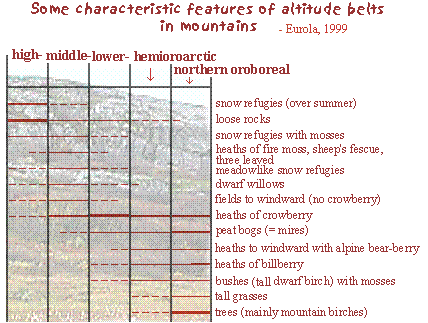
The depression areas on bare fjeld tops may gather a thick and late-melting snow cover,
and on these areas the growing season is as short as in arctic regions.
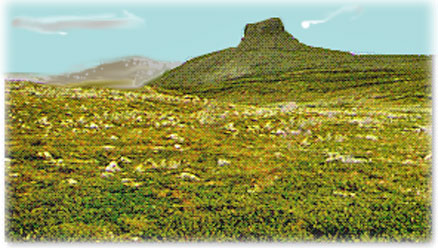
(Above):Totally treeless middle alpine zone of the fjeld area in Kilpisjärvi (Saivaara).
The majority of our fjeld top area (= paljakka) is classified as low alpine vegetation (lower oroarctic) consisting of several typical boreal forest species (dwarf shrubs, mosses, lichens) and some common alpine species. Abundant dwarf shrubs in the fjeld area are e.g. black bearberry (Arctostaphylos alpina), mountain heath (Phyllodoce coerulea). wild azalea (Loiseleuria procumbens) and diapensia (Diapensia lapponica). Some other rather abundant mountainous species are e.g. alpine rush (Juncus trifidus), alpine club moss (Diphasiastrum alpinum) and Lappish lousewort (Pedicularis lapponica). Close to the brooks you can find meny eutrophic meadowplants.
Typical features in middle alpine vegetation (in the mid parts of bare tops) are e.g. cassiope-alpine rush heathlands. There are plenty of snow refuges, but also windswept areas with a thin snow cover (see picture at the top!). For example, bilberry (Vaccinium myrtillus) is totally absent even from snow-covered areas. In the fells of the ‘arm’ part of Finland there are above 900m mid fell field (mid alpine) vegetation. Typical there are for example dry meadows of fire moss (Cassiope tetragona) and three-leaved rush (Juncus trifidus). And for example bilberry (Vaccinium myrtillus) doesn’t even grow in the places with snow shelter there. Also other forest dwarf shrubs are scarce there. There are a lot of snow beds (where lives for example snow buttercup (Ranunculus nivalis) and Saxifraga species) but also wind exposed places, where there isn’t much snow (see the picture on the right upper corner of the screen). In the middle of the fell field the boulder soil and terrain is buckled in the spring freeze.
The soil of bare mountaintops is mainly barren (silicate rocks, humid climate). Mountain heath (Phyllodoce coerulea), for instance, is a typical species of barren fjeld heaths (and fjeld birch groves!). The soil of bare mountaintops is usually podzolized but in places, it is mixed because of the soil freezing. Nature in the great fjelds of Enontekiö (e.g. Malla) and the fjelds of Pallastunturi and Ounastunturi (e.g. Takkaselkätunturi) is more luxuriant. For instance, heaths of mountain avens (Dryas octopetala), and meadows of rock sedge (Carex rupestris) can be found in those areas.
The arctic features intensify towards the north. The great fjelds of Enontekiö belong to the Scandinavian mountains. On Haltiatunturi fjeld (over 1100 a.s.l.), even high alpine vegetation can be found. In these areas, there is no regular vegetation cover, only mosses and lichens between the bare stone boulders. Few vascular plants e.g. glacier buttercup (Ranunculus glacialis) and mountain sorrel (Oxyria digyna) reach the high alpine level.
Above the timber line, in the peak area of fells the alpine vegetation (fell field vegetation) goes down in the northernmost parts of Fennoscandia even to the level of sea surface and combines into arctic tundra. Anyhow fell birch forests can be found sometimes in the very north, so we can ask, whether we actually have any real arctic tundra here in Fennoscandia? At least in Finland we don’t have real arctic vegetation.
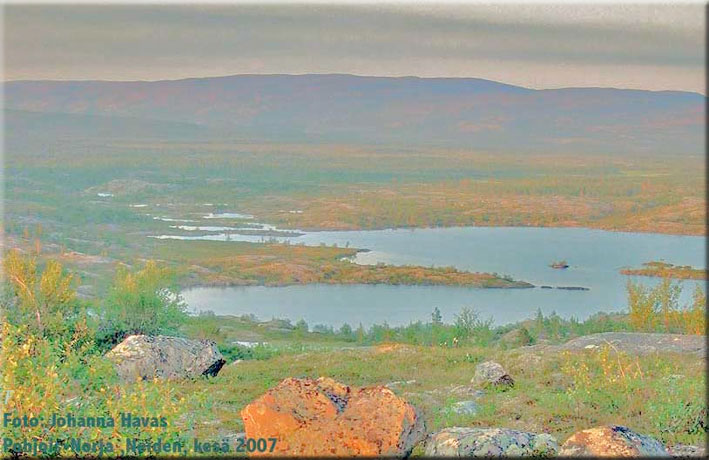
There is in several areas of the northernmost Norway disordered vegetation: open fjeld-, tundra-
and mountain birch-forestvegetation are living together. Like that in this picture, too.
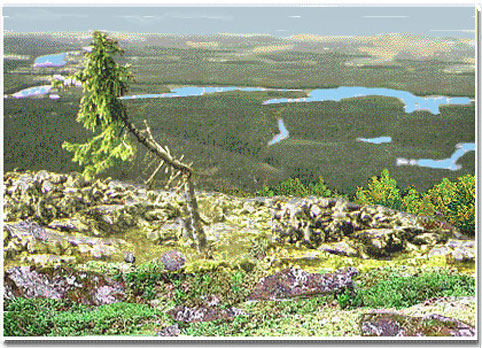
(Above): A view from the timber line; at the front, dry dwarf shrub vegetation
of the low alpine areas and a single small spruce damaged by wind and snow.
there is the mountain birch zone. In the background the "forest sea" of Lapland
with lakes and marsh patches.
The fell flora of Scandinavia can be divided into groups based on their distribution: centric species (rare, only in small area), bicentric species (in southern and northern fell area in the mountain range of the Keel, where the species in question might have been overwintering through the Ice Age) and ubiquistic (widely distributed) fell species. So on the present distribution of plant species has an effect not only the ecological factors but also the historical factors, too.